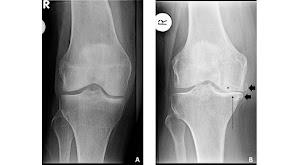Understanding Osteoarthritis.
 |
| Knee Pain |
Let's crack the term osteoarthritis. Osteo refers to the bone & arthritis is inflammation of (arthrosis) joint.
Osteoarthritis is a common degenerative joint disease in adults nowadays. It affects weight-bearing joints such as hips and knees and causes stiffness and pain in affected joints. It is usually age-related and progresses with age. Osteoarthritis is common in females (post-menopause) as it is related to estrogen deficiency.
Types of Osteoarthritis
It can be systemic, involving all joints, and localized, involving one joint.
There are 2 main types of osteoarthritis;
- Primary Osteoarthritis or Idiopathic OA.
This is the most common type of OA. Primary OA is when there is no known predisposing factor. It primarily affects the Spine, hips, great toes, fingers, and knees. 95% of cases of OA are idiopathic.
Some contributing factors are Genetics, Age-related cartilage degeneration, trauma, or injury due to mechanical stress.
- Secondary Osteoarthritis.
When the predisposing factor is known. Degenerative changes occur as a result of the previous pathology like injury to the joint, obesity, deformity, congenital abnormalities, surgery, hormonal disorders, prior inflammatory disease such as Rheumatoid arthritis, metabolic disorders, etc.5% of the cases of OA are of this type.
Stages of OA:
There are 5 main stages of OA. Symptoms vary depending upon the stage and become more aggressive as it progresses.
- Stage 0 - Preosteoarthritic Stage
- Stage 1 - Early or Doubtful OA (10% loss of cartilage)
- Stage 2 - Mild or minimal OA (Narrowing joint space with osteophyte formation at 2 points)
- Stage 3- Moderate OA (Joint space reduction is increased with more loss of cartilage)
- Stage 4 - Severe OA (60% of the cartilage is lost)
What are the symptoms of OA?
Symptoms may range from mild to severe depending upon the stage of OA. The symptoms may include;
- Pain in the affected joints.
- Stiffness or tightness - Reduced flexibility of the affected joint (particularly in the morning)
- Swelling
- Bony spurs
- Grating sensation while using the affected joint
- tenderness
What may be the causative factors of OA?
It can be hereditary in both cases, whether idiopathic or secondary OA. Other causes include;
- Age
- Cartilage deterioration
- Injury
- obesity
- Joint overuse
- Gender (common in females)
- Joint Malalignment
Risk Factors:
There are various risk factors related to this disability. Some are characterized as local, and others are systemic.
Local risk factors include;
- Obesity
- Occupation - Job involving straining your joints for longer hours.
- Physical Activity involving repetitive microtrauma.
- Sports Injury
- Repetitive, excessive load bearing
- Acute joint injury
Systemic risk factors include;
- Age
- Gender
- Hormones
- Nutrition
- Bone density
- Genetics
Diagnosis:
Look for tenderness, swelling, and flexibility.
X-rays should be done to diagnose OA. The osteoarthritic joint will be visible as bones fused together or narrow joint space.
Treatment:
As it is a degenerative disorder, it cannot be reversed, but its progress can be slowed down with medications and therapy. Most medicines are used to just elevate symptoms. These medications include;
- Acetaminophen - for mild to moderate pain
- NSAIDs - For mild to severe pain. They can cause gastric irritation.
- Cymbalta - for chronic pain.
Other treatment options may include articular injections such as Cortisone injections and lubrication injections, joint replacement surgery, etc.
Physical Therapy Management:
Physical therapy management for OA includes;
- Modalities such as TENS elevate pain and inflammation.
- Exercise - to improve joint flexibility, strength, and stability.
- Thermotherapy (intermittent hot and cold treatment)
- Manual therapy
- Supportive devices (orthotics and braces)
- ROM exercises
- Strengthening Exercises
- Muscle stretches
- Fall prevention strategies.
Prevention:
Primary prevention for osteoarthritis is to protect your joints and prevent them from injuries like falls and hits. For secondary prevention, early diagnosis is mandatory. Appropriate measures should be taken to slow the onset of OA after injury.
Tertiary prevention protocols involve slowing down the progress of OA and improving function so that patients can perform Activities of daily life (ADLs) actively.
Other preventive measures (Primordial prevention) include;
- Weight loss if you are obese.
- Good nutrition
- Moderate level of Physical Activity
- Avoid high-impact loading situations.
- Injury prevention
<script async src="https://pagead2.googlesyndication.com/pagead/js/adsbygoogle.js?client=ca-pub-2052134747868551"
crossorigin="anonymous"></script>
<!-- PT 1 -->
<ins class="adsbygoogle"
style="display:block"
data-ad-client="ca-pub-2052134747868551"
data-ad-slot="6891415940"
data-ad-format="auto"
data-full-width-responsive="true"></ins>
<script>
(adsbygoogle = window.adsbygoogle || []).push({});
</script>





.jpg)
Huh i was wondering about my knee pain and you resolved it now tell me date when should I visit at your hospital or clinic
ReplyDeleteThank You so much
ReplyDeletePerfectly explained.👌
ReplyDeleteProud of you my dear student.
Brilliant work
ReplyDeleteWaooo Vriii nyc...
ReplyDeleteThankyou. 🙌🏼
ReplyDeleteThank you
ReplyDeleteBrilliant Work 😊
Do something for sciatica too. I would love to share it with my clients. I'm impressed with your writing.
ReplyDeleteI will write you an email about details and if you want to work with me write it back.